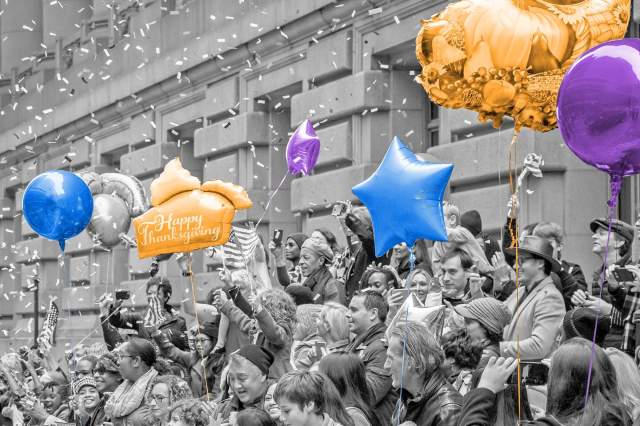
The First Parade Was Held in 1924
The first Macy’s Thanksgiving Day Parade, on November 27, 1924, looked decidedly different from the well-oiled contemporary versions that now chug through midtown Manhattan. Billed as “Macy’s Christmas Parade,” the marching gala covered just two city blocks and included an assortment of elephants, bears, and camels from the Central Park Zoo in lieu of balloons. On the other hand, it did feature the now-traditional element of a sleigh-riding Santa Claus, who beckoned children to the window display at the finishing point of Macy’s flagship store on 34th Street. Although the New York Herald devoted only two sentences to the event the following day, the parade was enough of a success for Macy’s to immediately announce a sequel for the following year.

Early Artistic Director Tony Sarg Introduced the Parade’s Balloons
The development of the Macy’s parade into an immensely popular attraction is largely due to the efforts of its early artistic director, Tony Sarg. An illustrator, puppeteer, and inventor, Sarg designed the marionette-filled Macy’s window display that capped the inaugural gala. More importantly, he introduced the giant balloons that are now indispensable to the proceedings; the first one, Felix the Cat, took flight over marchers and onlookers in 1927. Sarg continued to design new balloons for Macy’s, as well as for parades in Philadelphia and Boston, until his death in 1942.

Approximately 50,000 Hours of Labor Are Expended Toward the Parade
So what goes into the making of this annual spectacle? According to the record-keepers at Ripley’s, a typical parade sees 200 pounds of glitter applied to each float and 750 pounds of gas used to inflate one balloon. Additionally, more than 300 wardrobe and makeup artists are hired to tend to the 600 performing cheerleaders and dancers, 2,800 marching band members, and 1,600 balloon handlers. Altogether, some 50,000 hours of labor are expended each year by Macy’s employees in the buildup to one momentous morning designed to entertain the 3.5 million fans regularly in attendance.
More Interesting Reads

The Parade Halted for Three Years During World War II
Although the parade normally goes on, rain or shine, it was suspended from 1942 to ’44 when valuable resources were diverted to the war effort. Specifically, the precious helium normally used to inflate balloons was instead earmarked for blimps, while the material used to create the balloons themselves became 650 pounds of scrap rubber. When a helium shortage again posed a problem for the 1958 festivities, organizers worked around it by deploying vacuum cleaners to fill the balloons and cranes to carry them along the parade route.

The Giant Balloons Occasionally Produce Accidents
Although everyone loves the Snoopys and Kermit the Frogs that drift over the festivities, these titanic balloons have caused their share of problems over the years. Initially, they were allowed to drift away after the parade’s end, with a reward offered for their return, until one pilot nearly crashed her plane as she chased down a floater in 1932. In later years, a Popeye the Sailor balloon drenched the crowd with water from his rain-filled hat in 1957, and an errant Sonic the Hedgehog crashed into a streetlight in 1993. But the biggest balloon-related disaster came when strong winds pushed the Cat in the Hat into another streetlight in 1997, producing a debris shower that injured four.

Macy’s Parade Studio Employees Are on the Job Year-Round
While most of us don’t think about the parade until sometime close to Thanksgiving, it’s a year-round job for the 26 full-time painters, carpenters, sculptors, and metal workers employed at Macy’s Parade Studio. Located in a warehouse in unassuming Moonachie, New Jersey, the facility is big enough to store and test the durability of each balloon before its Thanksgiving appearance. A more complicated endeavor is the creation of new floats, which can take four to nine months from the time of the earliest sketches to the finished product. The kicker: Each float needs to be partially deconstructed into an 8.5-foot-wide vehicle in order to fit into the Lincoln Tunnel for its trip to New York City.

The Parade’s Drivers Are Union Folk
Largely unnoticed but nevertheless crucial to the parade’s proceedings are the drivers in charge of towing the bulky floats. As members of the Teamsters Local 817 union, which represents transportation and other workers in the film, TV, and theater industries in New York City, the drivers are asked to wear jackets and ties for the occasion, even if they’re largely hidden in their trucks. Apparently few look forward to the responsibility of pulling Santa’s parade-tailing sleigh, which involves a lot of waiting around. And all drivers bear the burden of getting their floats back to the New Jersey facility on their own, which usually entails dealing with some gnarly holiday traffic.

Attendees of the 2012 Parade Found Surprising Information Among the Confetti
Although most people in attendance can count on being entertained by the sights and sounds of the parade, few expect to become privy to confidential information by way of the confetti showered along the way. But that’s what happened to a group of college students near 65th Street and Central Park West in 2012, who found Social Security numbers, arrest records, and details of presidential candidate Mitt Romney’s motorcade route among the shredded papers in their vicinity. Following an investigation, it turned out that the leaked information was courtesy of a member of the Nassau County Police Department, who apparently used office documents to create a batch of homemade confetti.

A Smaller Production Was Prepared for the COVID-Affected 2020 Parade
Although a world war scuttled the annual parade in the early 1940s, Macy’s wasn’t about to let a global pandemic do the same to the 2020 gala. Taking every precaution possible, organizers slashed the regular participating workforce of about 8,000 people to under 1,000. The diminished help was offset by reductions in the number of balloons (from 16 down to 12) and floats (26 to 18). The parade itself lasted one block across 34th Street, way down from the standard 2.5-mile route, as fans were discouraged from attending. Yet the TV coverage managed to fill up the regular three-hour time slot from 9 a.m. to noon, thanks to the staggering of live footage with prerecorded musical acts, and the entire affair mostly kept pace with viewership of previous parades, with 20.7 million people tuning in to get a glimpse of normalcy during that COVID-marred year.












